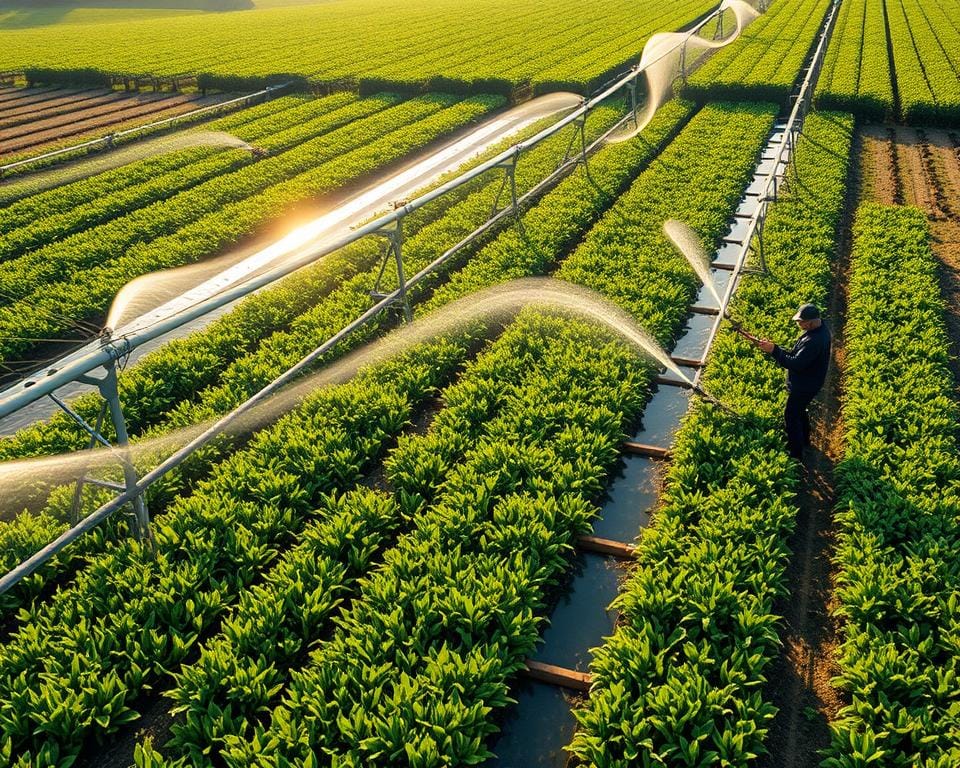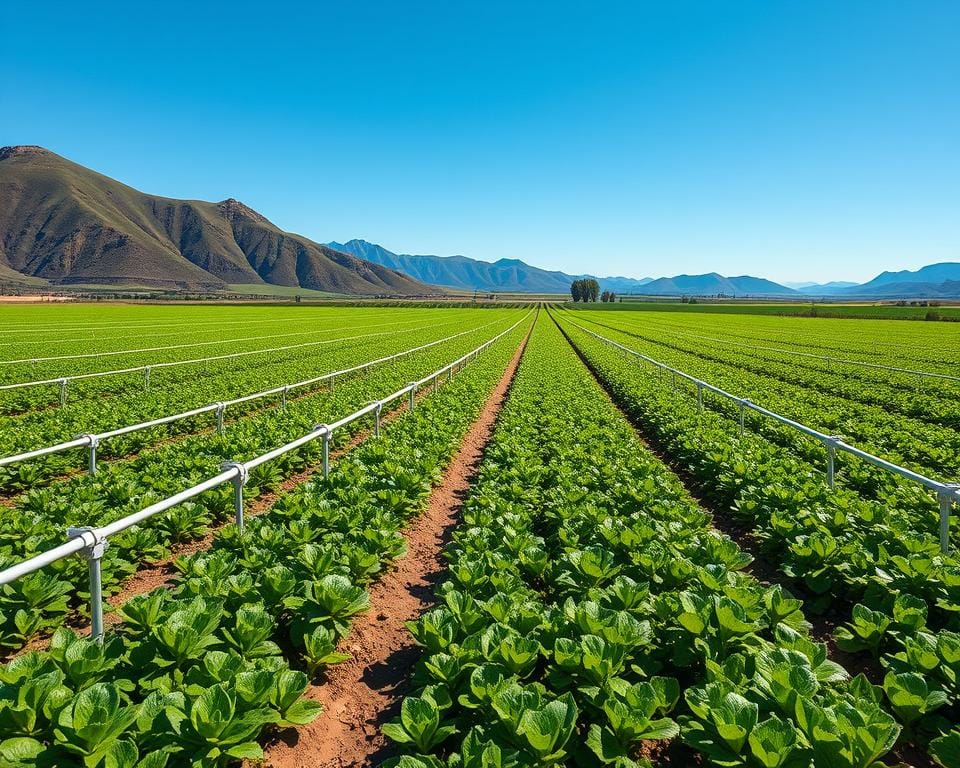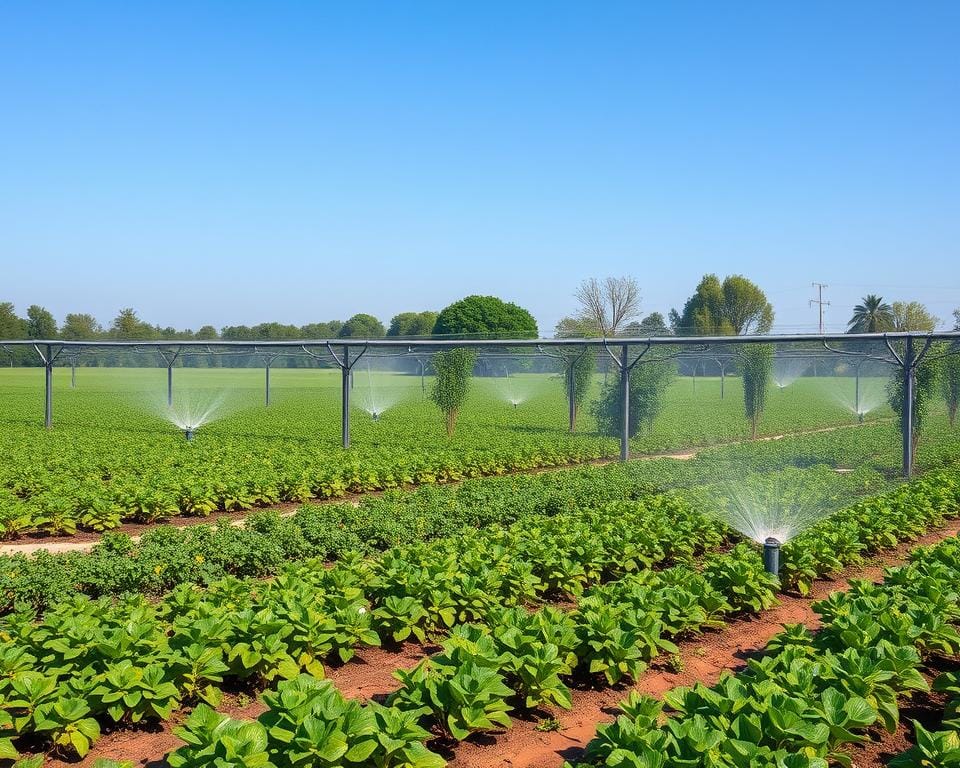Agriculture uses over 70% of the world’s fresh water. It’s key to use sustainable farming to support our growing global population. Improving how we use water for irrigation helps save water and keeps farming economically viable. Farmers should use cost-effective, modern tools like precision irrigation.
Using advanced irrigation methods like drip systems can greatly reduce water waste. These systems can be 95% efficient. Adding smart irrigation controllers and sensors also helps. They give real-time data to use water more precisely. Traditional flood irrigation is much less efficient, only 30-40%. Furrow irrigation does a bit better, at 55-70% efficiency.
Technologies like the Saaras sprinkler system make irrigation even better. By upgrading old systems, farmers can spread water more evenly and find leaks faster. This supports not just better farming, but also puts water conservation at the forefront of agriculture.
It’s also important to teach farmers and others in agriculture about these improvements. Training programs should show the value of new tech and changing how we farm. Things like rotating crops and less plowing can greatly save water. Focusing on better irrigation helps keep food production sustainable. It also tackles problems like water shortages and climate change.
Introduction to Irrigation Water Efficiency
Making irrigation more efficient is key in battling water shortage and promoting sustainable farming. A big chunk of the world’s fresh water goes to agriculture, so it’s crucial to use water wisely in this sector. By improving how water is managed in farms, we save important resources, help farmers keep their crops healthy, and cut down costs.
Understanding Water Usage in Agriculture
It’s important to look at how water is used in farming. Old-school irrigation often wastes water, with leaks losing 20-50% of it. Switching to drip irrigation, which sends water straight to the roots, can boost water efficiency by 50%. This method also reduces nutrient wash-away and erosion, leading to less harm to the environment. Adding soil moisture sensors cuts water use by another 30%, making sure water is only used when needed.
The Importance of Efficient Water Management
Managing water well in agriculture is critical to tackle water scarcity. Using mulch cuts soil water evaporation up to 70%, which is highly effective along with other eco-friendly farming methods. Also, timing irrigation with the help of weather-based calculators can raise efficiency by 20%. By adopting these measures and tools like the Agricultural Irrigation Scheduling Calculator, farmers can better control water use, improving it by 25-30%.
Furthermore, new tech in irrigation, like automated systems, refine how water is applied. Weather sensors and smart irrigation not only save water but also cut costs in the long run. This supports sustainable farming that can endure over time.
Assessing Your Current Irrigation System
To get the most out of irrigation, start with a full check of your system. Looking at how your irrigation works lets you find where improvements are needed. This boost its performance and saves water.

Evaluating Water Distribution Uniformity
Uniform water spread is key to a good irrigation system. Checking water distribution spots areas with uneven watering. This can cause uneven plant growth and waste water.
Michigan State University’s research shows fixing water spread saves a lot of water and energy. Regular checks ensure water reaches all parts of your fields evenly. This helps plants grow well and saves resources.
Identifying Leakages and Inefficiencies
Spotting leaks and inefficiencies is also crucial. Checking for leaks stops water waste and keeps your system efficient. Regular checks find leaks, broken parts, or other issues that might be missed.
Fixing leaks and updating systems cuts down on water use. This leads to better farming methods. Keeping your irrigation system in check means it performs well. These steps lead to big water savings, better irrigation, and sustainable farming.
Implementing Advanced Irrigation Technologies
To make irrigation more efficient, it’s key to use advanced tech. This includes things like advanced drip irrigation systems and smart irrigation controllers. By doing this, farmers can really up their game in managing water.
Drip Irrigation Systems
Advanced drip irrigation changes how we use water in farming. It sends water straight to the plant’s roots. This cuts down on waste and makes sure plants get just enough water. Considering that farming uses about 70% of the world’s freshwater every year, upgrading is a must. Tools like those from WiseConn help farmers easily switch to these water-saving systems.

Smart Irrigation Controllers and Sensors
Smart irrigation tech uses controllers and sensors to get water right where it needs to go, based on current data. Products from WiseConn, like soil moisture sensors and smart controllers, are great for this. They use data to fine-tune watering schedules. This means big water savings without hurting crops, as seen in Michigan trials.
- Increased crop yield and improved crop quality due to consistent moisture levels and reduced plant stress.
- Improved operational efficiency by streamlining farm operations with automated systems.
Climate change and city growth spur the need for newer irrigation methods. WiseConn’s automated systems meet these challenges head-on. They offer smart controllers, sensors, and software for better farming. For more on water-saving tech, see the review of advanced irrigation controls. Also, discover the need for permits and other details at water softener installations.
| Traditional Methods | Modern Methods |
|---|---|
| Gravity-driven irrigation | Advanced drip irrigation |
| Manual control | Smart irrigation controllers and sensors |
| High water wastage | Water-saving automation |
| Less efficient | Precision agriculture for optimized yield |
Optimizing Crop and Soil Management
Optimizing how we handle crops and soil is key to increasing water efficiency and crop yield. Practices like rotating crops thoughtfully and minimal tillage help keep soil moisture. Understanding what each crop needs and using smart methods to meet those without wasting water is the first step in water conservation through crop management. I’ve seen these methods not only save water but also make soil healthier, leading to more produce.
Rotating different crops in a planned way helps keep soil wet. This approach fights soil erosion, boosts nutrient recycling, and betters soil structure. Conservation tillage, or disturbing the soil less, keeps soil wet by cutting down evaporation and helping water sink in. The FAO and studies by Yara International show these strategies, along with better irrigation, boost farm output and water use efficiency.
In areas desperate for water, where a lot of new irrigation has been introduced, these sustainable tactics are crucial. They help us reach worldwide goals like dealing with climate change, growing economically, and building sustainable communities. Techniques to manage soil moisture, like mulching and planting cover crops, can slash water needs by 25% or more. We must keep improving, researching, and watching over these methods to manage the balance among climate, water, food, and energy. Investing in sustainable approaches means we’re not just saving water—we’re building a strong, sustainable farm system.

